New Green Rainham Home User Guide





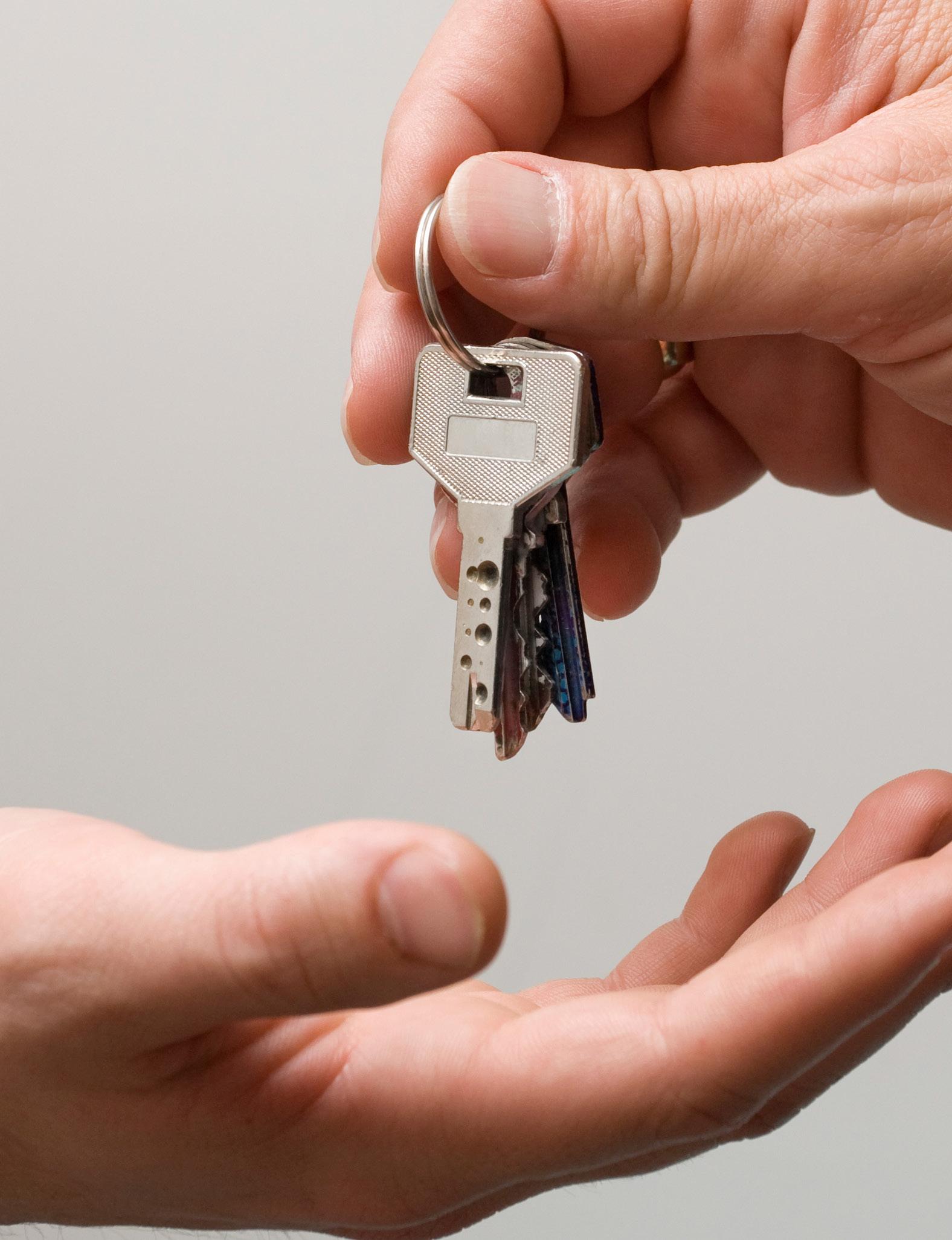
Welcome to your new home, which we hope brings you joy and happiness. Our contractors and the London Borough of Havering have taken pride in building your brand-new home and have provided this guide to help you look after it and use it effciently and correctly to give you many years of happy living. It is our aim for you to feel safe and secure, warm, and sheltered in your new home. We also appreciate that it is the personal touches that make a house a home and have a section on helping you do this safely.

We want you to be proud to live here, together with your neighbours as part of the local community, making this a great place to live.
This Home User Guide has been prepared to help achieve this. Please keep it handy as you will refer to it many times during the frst 12 months and beyond. You’ll fnd lots of answers in here which can save you time and energy to help solve simple problems. We have also included details of where to report a defect or something wrong if you need to.
Sometimes items in a new build can need some attention when things are frst used or require adjustment, don’t be worried or alarmed; we are here to help and support you and provide advice and information when required. Some things in a new home are very normal but you wouldn’t experience them in an older property, we cover these areas in Section 3, to give you information and peace of mind.
And remember, you are building a community together. You all have different skills and experiences in life, so remember to ask each other too. Someone else may have information, hints, and tips to share with you and you can also share yours.
We wish you happy living at New Green Estate.

Createmaster Limited has provided this user guide to the Developer to assist you, the residents, in the looking after of their property. The user guide was correct at the time of building completion. The London Borough of Havering may from time to time add, alter or omit information from this user guide in order to conform to the policies. They may also make alterations to the building and services. Therefore, the information contained herein should be used as a guide only and occupiers should independently verify the details before acting upon them. All services should be traced and isolated by a competent person.
We have created a series of ‘how to’ flms to help you settle into your new homes. The flms cover everything from how to heat and ventilate your home, to how to welcome visitors. They are available on Havering Council’s YouTube channel which can be viewed here: www.shorturl.at/nrL45 or use the QR code below:
Several measures were taken into consideration during the building’s design and subsequent construction, which now determine its energy usage & effciency. This helps the environment by limiting the impact of energy generation and usage / wastage.
The Apartments are ftted with 100% dedicated energy effcient light fttings to maximise energy effciency and reduce the energy required for lighting.
Water consumption in the development is minimised by utilising a number of measures such as water effcient taps, showerheads and water-saving appliances.
Energy metering is provided within all Apartments. A network of meters have been installed throughout the risers on each building to monitor your electric and water use.
The HIU (‘heat interface unit’) and acts like a boiler to create heat and hot water for your home) it also monitors the heat used in Kilowatts and record this data via a meter. The meter is read regularly and is used to bill the end user for the heat used from the main plantroom.
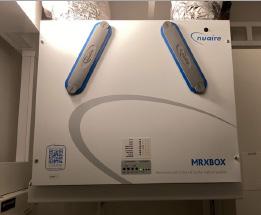
Your home comes with a mechanical ventilation and heat recovery system. The extract fan unit serving your home is in the utility cupboard.
The area above the ceiling should not be used for storage in order to allow clear access for any future maintenance requirements.
This fan runs continuously and should not be switched off as this will lead to condensation issues in your home. Fan boost is provided by the light switch in the bathrooms and a manual switch in the kitchen.
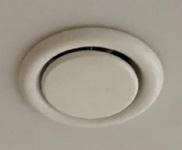
Appliances that display the energy saving recommended logo meet or exceed specifed energy effciency requirements and are backed by the Government. It is your guarantee that the product will save energy, cost less to run and help the environment.
The EU energy labelling system rates products from A+++ (the most effcient/least energy using) down to G (the least effcient / most energy using).
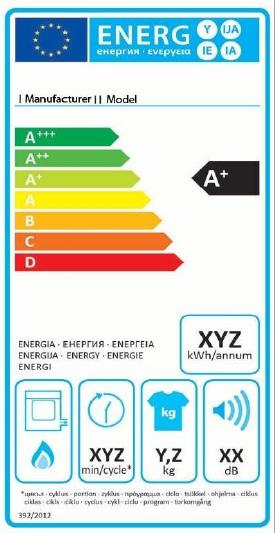
By law the label must be shown on all refrigeration and laundry appliances, dishwashers, electric ovens and light bulb packaging.
The most effcient products also carry the energy saving recommended logo. For more information on where to buy Energy Rated Appliances visit the Energy Saving Trust website at www.energysavingtrust.org.uk or phone their helpline on 0300 123 1234
1 Turn off lights and sockets when not being used
2 Use energy saving lightbulbs
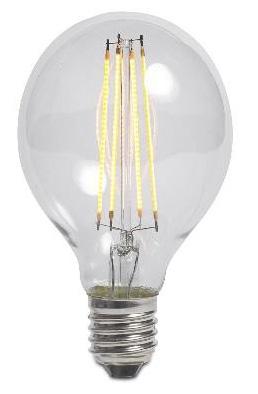
3 Keep heating at a comfortable level
4 Do not overfll kettles; boil just the amount you need. Be sure to put enough water in the kettle to cover the electric element

5 Let warm food cool before you put it in the fridge / freezer
6 Defrost fridges / freezers on a regular basis. When ice builds up you waste energy
7 Keep your freezer at least three quarters full
8 Do not open the fridge or freezer door more often than you need to.
9 Try to get everything you need out in one go and do not leave the fridge / freezer open while using an item and before putting it back
10 De-scale kettles regularly, they will boil quicker and cost less. Follow the kettle rinsing / cleaning instructions carefully
11 If you have a washing machine, wait until you have a full load to wash. The same applies for the dishwasher
12 Use the Eco wash mode if provided on washing machines and dishwashers When not in use, keep appliances turned off at the mains and do not leave them on standby.
Some appliances will use almost as much energy in standby as they would when they are in use. The above information is provided by the Energy Saving Trust. Mor
A running tap uses a lot of water
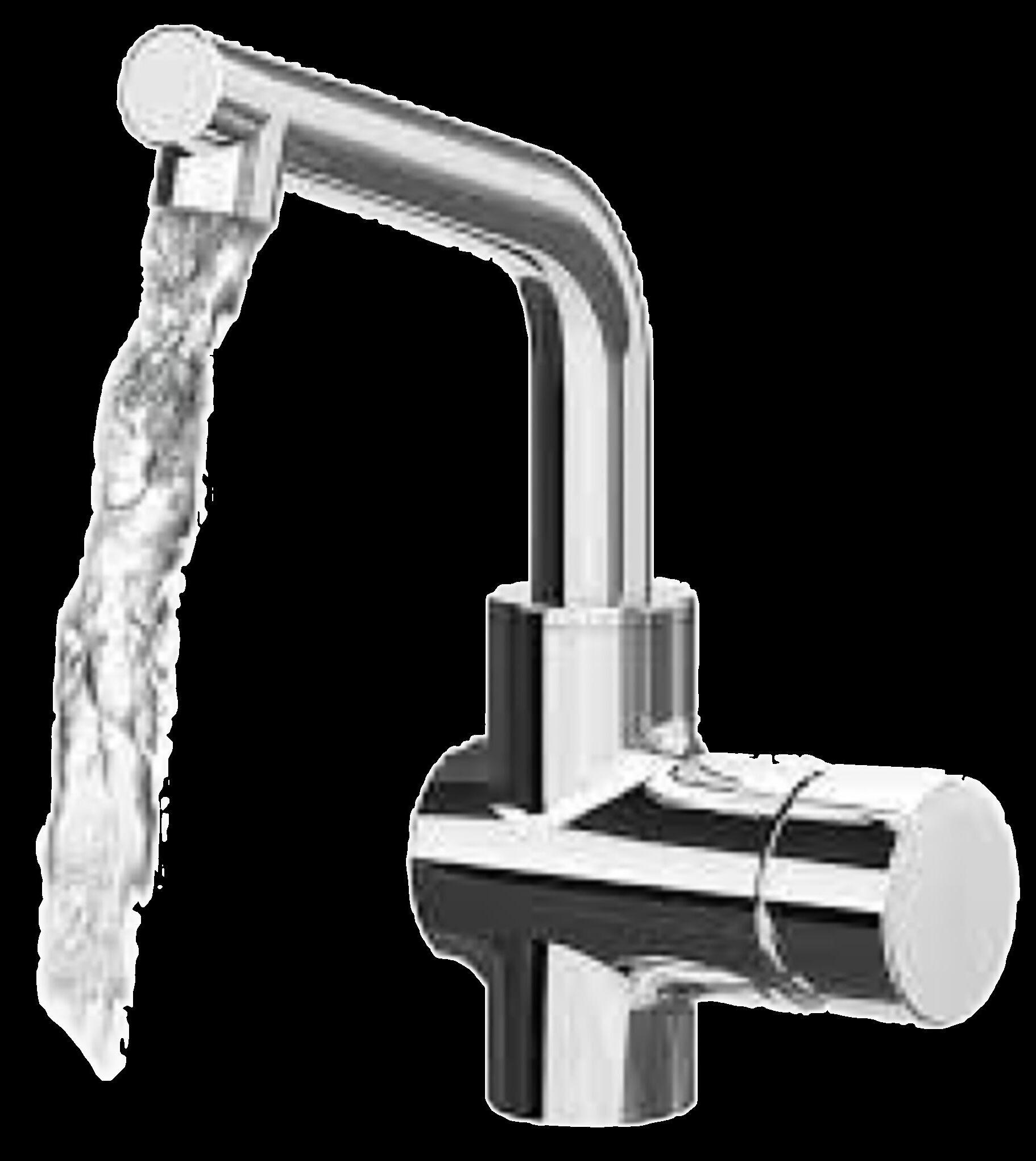
1 Don’t leave water running, use a plug
2 Use a bowl for washing fruit and vegetables
3 Don’t leave the tap running whilst brushing your teeth
4 For a cold drink fll a covered jug and place it in the fridge to cool instead of running the tap
5 Fix dripping taps. A dripping tap can waste enough water in a week to half fll a bath
6 Take a shower instead of a bath
7 If you have a washing machine, wait until you have a full load to wash. The same applies for the dishwasher
8 Check for leaks on the water supply pipe to your home on a regular basis. If a leak is identifed, then have it repaired as soon as possible.
The bulk refuse store is located on the Ground foor Dunedin Road. If you have bulky items requiring removal, please contact Havering Council Housing Contact Centre on 01708 434000 (Monday to Friday - 9am to 5pm).
Underground Refuse System bins are located on Dunedin Road, outside of Masterson Court and the central walkway. The remaining Underground Refuse System bins can be found outside of Brooksmouth Court on New Road.
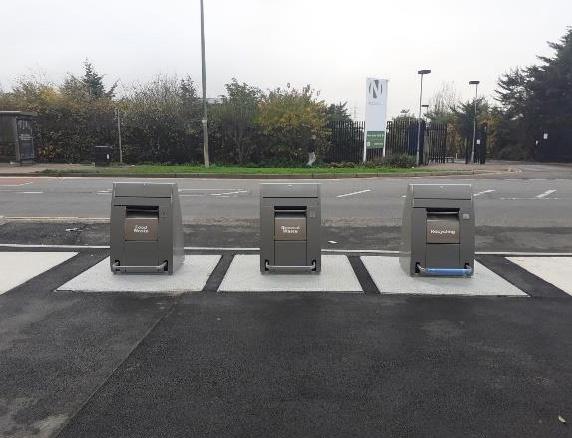
Please ensure that your refuse is suitably and properly bagged so as not to cause any spillage across the corridors and communal areas.
These bins are labelled to allow for general waste, recycling and food. In the interest of hygiene, please use the bins accordingly and do not leave rubbish on the foor as this can encourage rodents.
Please rinse any glass, plastic or metal food packaging prior to disposal in the recycling bins e.g., wine bottles, plastic milk cartons, food tins.
When you move into your new home you should make and agree with your family a Home Fire Action Plan and practice your escape plan. You should take into consideration all family members who may have particular needs, for example the elderly and children, so everybody knows what to do, how to get out and where to go and assemble in the event of a fre inside your home.
This section provides you with a brief overview of the key fre safety information that as a new resident you need to know for you and your family’s safety.
The property, in which you are living, will have certain fre safety features built in to aid your safety in the event of a fre and assist you to escape safely should a fre start in your home.
You need to consider your fre safety and what to do in the event of a fre. Think about:
How you would evacuate your property if you needed to and the exit route you would need to take Take everyone into account - this includes children and the elderly.
How you might raise the alarm and alert your neighbours
Calling the Fire and Rescue Service as soon as possible
What do I do if a fre breaks out? If you are in the room where the fre is, leave straight away together with anybody else, then close the door. Don’t try to tackle the fre unless you have suitable training. Close the front door and leave the building, and then call the fre service on 999.
If a fre breaks out elsewhere in the building for blocks of fats, should I stay in my home or get out? You should follow the procedure according to the notices in your development. For some of you the best course of action is to “stay put”. For others it is to leave the building as soon as possible. Each building has a specifc procedure that is designed according to the design of the building and the provision of safety features, such as fre doors and emergency lighting.
In the blocks of fats which have shared escape routes there is a fre action notice on ground foor of your building. Please make sure you know where the notice is and take a few moments to read it, as it will explain the procedure you should follow in the case of a fre.
If a fre breaks out outside your home, it is usually safer to stay in your home until you can be safely evacuated by fre fghters. If smoke and fames enter your home leave at once and close the door behind you, then call the fre service on 999.
We have in place specifc fre safety measures that are tailored to your building. The measures and procedures for fre safety may vary from building to building, depending on the building type. These measures are reviewed annually by qualifed and certifed fre risk assessors. Every building with an internal communal area must have a Fire Risk Assessment (FRA) which reviews the fre safety measures in place. In some cases, the review must take place every year. In other cases where there is a lower risk to safety it is every three years.
If you consider you may have diffculty in evacuating the building, then you must make Housing Management at the London Borough of Havering aware of your situation.
Every building will have some level of ‘fre resistance’ built into the fabric of the walls, foors and ceilings providing ‘fre compartmentation’ between different properties.
Walls, ceilings and doors hold back fames and smoke, so if there’s a fre somewhere else in the building, you’re usually safest staying in your fat unless you’re affected by heat or smoke. It is important this ‘fre resistance’ is maintained as it prevents a fre from spreading between rooms and properties to support the stay put strategy.
Part of the fre resistance is also provided by fre doors, and these play a crucial part in the fre safety of a building. Keeping doors closed and in good working order with no holes will help to stop the spread of fre and smoke in a building.
Purpose built blocks of fats are designed to be fre-resisting, and most fres won’t spread further than one or two rooms. Any fre should not involve the common areas of the block or spread to other fats.
Depending on your building and the fre safety measure in place will depend on what equipment is provided. All properties will have fre doors and it is important these doors are kept in good working order. Further equipment includes smoke alarms and detectors, automatic smoke vents, emergency lighting, fre signage, dry rising mains and fre extinguishers.
Fire safety equipment provided in communal areas of blocks of fats is formally tested and checked regularly by your Housing staff or our appointed external Contractors.
Please do not tamper with the fre safety equipment that is provided in your block as it is there to ensure yours and others safety. If the equipment is damaged or you are concerned it may be faulty, please report it to us so we can fx it.
There is a lot you can do to reduce the chance of fre in their building. In particular we are asking residents to:
Test your smoke alarms inside your home at least once a month. If you have any doubts that it might not be working properly, please contact us to have it checked. If your smoke alarm keeps going off, don’t disconnect them. (See 13.7 Appendix)
Do not leave items in the communal areas as these pose a hazard to the shared escape routes. When our staff see anything in shared areas that could present a serious fre hazard – such as door mats, mobility scooters, buggies or bicycles – they may remove the items without notice.
Dispose of rubbish properly. Use the appropriate bins refuse areas.
Do not leave rubbish bags in the common areas.
Take care when cooking and don’t leave cooking unattended. Don’t throw rubbish or cigarettes out of windows.
Keep doors closed at night - this will delay the spread of fre and smoke.
Please take a moment to read the fre evacuation notice/procedure for your building.
Public transport
Location
Details of service
C2C Services
Mainline Train Station Rainham Railway Station
Betterton Road (Stop S)
Spencer Road South Hornchurch (Stop K)
Bus Stops
Marsh Way (Stop MJ)
Marsh Way (Stop MD)
Towards Grays Towards London Fenchurch Street Towards Pitsea
287 Barking
365 Havering Park 287 Rainham, Abbey Wood Lane
174 Harold Hill
174 Dagenham Marsh Way
Travelling either around your local area or on holiday to faraway lands can put pressure on the environment, as extra carbon and greenhouse gas emissions are emitted.
Walking icon

Take the bus or walk – Especially for short, local journeys – public bus services or walking can save carbon emissions, time and money. It can help your ftness levels too!

Train

Get cycling – Cycling is good for you, good for the environment, it’s fast, it’s convenient, it gives you freedom and independence, takes you from door to door and is reliable. For cycle routes, please see the following map or cantact Transport for London (TfL) for a free map (see details below)
Take the train on holiday – Taking the train instead of a car or plane can help relieve your stress levels as well as getting you there quicker. By taking the train you could also cut your carbon emissions by up to 80%•.

Offset any fights you take – Carbon off-setting schemes are available to help you calculate your CO2 emissions and then to donate money into offsetting schemes such as tree planting, research and grants for new green technology and future schemes,
• Information taken from the big green switch website https//www.biggreenswitch.co.uk
Travelling either around your local area or on holiday to faraway lands can put pressure on the environment, as extra carbon and greenhouse gas emissions are emitted.
Sustrans Mainline Train
Station logo
National Bus Stops Rail logo
National Express logo


Sustrans
Web: www.sustrans.org.uk
Tel: 0845 113 00 65
Sustrans is a sustainable transport charity. The website includes information about the National Cycle Network, cycle routes and other cycling events.

National Rail Enquiries
Web: www.nationalrail.co.uk
Tel: 08457 48 49 50
The service provides advice on journey planning and train service updates. It has operator information, latest changes and disruption information.
National Express
Web: www.nationalexpress.com
Tel: 08705 808080
National Express is the largest scheduled coach service provider in Europe. The coaches operate to 1000 detinations all over the UK. The website has coach route and ticket information.
Amenity Location
Grocery – Bridge Rd, Rainham RM13 9YZ
Afro-Caribbean Store – 24 Broadway, Rainham RM13 9YW
Food Shops
Food & Wine – 111 Upminster Rd South, rainham RM13 9AA
Butchers – 9 Rainham Rd, Rainham RM13 8SP
Food & Wine – Rainham RM13 8ES
Post Offce – 185 Cherry Tree Ln, Rainham RM13 8TU
Post Offces
Banks
Rainham Post Offce – 77-79 Wennington Rd, Rainham RM13 9TH
Bank ATM – TESCO EXTRA, Bridge Rd, Essex RM13 9YZ
Bank ATM – TESCO EXPRESS, Rainham Rd, Essex RM13 7QX
Pharmacy – Bridge Rd, Rainham RM13 9YZ
Pharmacy – Ferry Lane Industrial Estate, Lamson Rd, Rainham RM13 9YY
Pharmacies
Pharmacy – 113 Rainham Rd, Rainham RM13 7QX
Chemist – 139A Wennington Rd, Rainham RM13 9TR
Pharmacy – 6 Crown Parade, Upminster Rd South, Rainham RM13 9BD
Catholic Primary School – Dunedin Rg, Rainham RM13 8SP
Primary School and Nursery – 119 Upminster Rd South, Rainham RM13 9AA
Schools
Junior School – Blacksmith’s Ln, Rainham RM13 7AH
Primary School – Lowen Rd, Rainham RM13 8QR Academy – Ford Ln, Rainham RM13 7XJ
Health Centre – Upminster Rd South, Rainham RM13 9AB
Medical Centre – Health Centre, Upminster Rd South, Rainham RM13 9AB
Medical Centres
Medical Centre – 39 Frederick Rd, Rainham RM13 8NJ
Health Centre – 106 South End Rd, Rainham RM13 7XJ
Leisure Centre – School Rd, Dagenham RM10 9QH
Leisure Centres
Leisure Centre – Gosfeld Rd, Dagenham RM18 1DN
Leisure Centre – Althorne Way, Dagenham RM10 7FH
Community Centre – Davies Cl, Rainham RM13 9LJ
Community Association – Nelson Rd, Rainham RM13 7RD
Community Centres
Community Centre – South St, Rainham RM13 8PJ
Community Centre – 150A Oval Rd North, Dagenham RM10 9EH
Community Centre – 25 Wellington Dr, Dagenham RM10 9YP
Worship Centre – 76 Frederick Rd, Rainham RM13 8NR
Places of Worship
Grocery – 3 Upminster Rd South, Rainham RM13 9YL
Grocery – 143 Rainham Rd, Rainham RM13 7RB
Except for reporting defects (repairs or faults caused by failure of workmanship) if you have general enquiries you should contact:
London Borough of Havering Town Hall
Main Road Romford
RM1 3BB
Tel: 01708 434000
Your apartment is subject to 24 months warranty period (known as the Defect Liability Period), contact Havering Council.
A defect is a fault/repair that occurs due to failure of workmanship within the frst 24 months from handover. Please note that this period commences from the date of Practical Completion of the building and not necessarily from the date you occupy your property.
Important – Any repair not related to defective workmanship or materials will not be covered by the defect liability period. Generally, these are the responsibility of the resident e.g.
Damage due to wear and tear
Damage due to misuse
Incorrect operation or maintenance of components – not following the user instructions
Please also note that if you have reported a defect and a contractor attends your property and it is found that no defect is present then you may be charged for the visit.
Residents of Affordable housing and Shared Ownership will have to report defects to Havering council. Details are given below: London Borough of Havering.
For out of hours emergencies, you can contact on 01708 433999 (Monday to Friday - 5pm to 9am and all-day Saturday and Sunday and on a bank holiday)
London Borough of Havering aim to respond to emergency repairs within four hours. General repairs take place between 8am and 8pm Monday to Friday, and 8am to 1pm on Saturdays. Repairs phone line 01708 434000
Priority One (Emergency Repairs) – 4 Hours
These are defects that are:
• Life threatening
• Causing a loss of essential facilities
• Affects the security of the property and its residents
• Affects the immediate health of the residents
• Will lead to severe property damage if allowed to remain unattended.
Priority Two (Urgent defects) – 5 working days:
These are defects that can be defned as causing a loss of facilities that may become life threatening or lead to a loss of essential facilities if left to deteriorate further or cause serious inconvenience to the residents.
Priority Three (Non-Emergency Repairs) – 28 working days:
These are defects, which can be deferred without causing serious inconvenience to the residents.
Please see attached “Generic Trouble Shooting” document in section 13.1
London Borough of Havering is responsible for managing the building, which includes the day- to-day upkeep of the common areas, communal car park and outdoor areas.
In the frst instance of anything to report regarding the estate please contact Havering Council Housing Contact Centre on 01708 434000 (Monday to Friday - 9am to 5pm) or go to www.havering.gov.uk
Post boxes are located in the entrance lobbies at Ground Floor of all blocks. No concierge is available at the development. Use of smart lift to allow deliveries to your door.
If you are in the lift when it breaks down, then press the alarm button and speak to the operator who will provide assistance.
Please do not overload the lift or force the doors open.
For operation see Gamma Systems document within Resident Handover pack.
If you need to move heavy goods or bulky items then please provide the residents service manager with your requirements giving suffcient notice, in advance, in order that appropriate measures can be undertaken to meet your requirements. This is so the lift can be suitably protected to avoid any damage.
All-cycle spaces are covered aside from 6no. external Sheffeld stands within the central green pathway between the buildings. Cycle Stores can be accessed via the car parks and 1 no. cycle store can be accessed from New Road with a fob.
The Car Park within the development contains 93 parking spaces of which 10 are disabled bays and 1 motorcycle bay.
Spaces can be rented by customers subject to certain criteria being met, contact Havering Council for further details. Please note there is no parking space available for visitors.
Ground Floor communal areas are accessible to all residents and the general public. First Floor gardens are accessible to residents from communal areas.
London Borough of Havering is responsible for arranging the day-to-day cleaning of the communal areas within the building, which also includes the corridors, communal car park and outdoor areas.
London Borough of Havering estate services team is responsible for cleaning the interior spaces of the communal area. They will clean internal communal glass i.e., glass in doors, any windows that are in the communal areas.
London Borough of Havering will be responsible for cleaning the communal windows in your block, this will be included in your service charge.
Communal windows will be maintained on a quarterly basis.
Please Note:
You must not make any alterations to the property without prior approval from the housing management team. Please call Customers Services Centre on 01708 434000.
A communal aerial is supplied.
Terrestrial and satellite wiring has been installed in your home.
A live point is located in the master bedroom, there is another point in the living room which can be connected. You may need to tune your own TV to the local settings.
As this is a new home, you need to contact BT /other provider to arrange for an exchange line to be connected for your use. Any connection of additional sockets may be chargeable.
Telephone points are installed in the master bedroom and living room.
You must not drill into or nail into the foors or walls as electric cables or pipes may lie underneath.
Your home is ftted with an Extract ventilation which is provided to your home via a continuously running extract fan which should not be turned off.
Your home needs to dry out because building materials absorb water during construction. The moisture will evaporate causing shrinkage which shows as cracks in the plaster. This is perfectly normal. Do not be alarmed.
As moisture evaporates condensation may appear on internal windows. To help discourage condensation, leave windows slightly open particularly at night.
To reduce the moisture in your home and avoid excess condensation the following tips will help: Put lids on saucepans.
It is essential that kitchens are well ventilated when drying clothes and cooking. Use the extract fan, where provided, and keep the kitchen door shut if possible. After emptying the bath, shut the door and leave any windows open or the fan on to allow the moisture to escape.
Ventilate your kitchen and bathroom for about 20 minutes after use. Keep the door shut to avoid moisture getting to other parts of the home.
Keep rooms ventilated. Modern fats and homes are very well insulated therefore a window or ventilator will need opening for suffcient periods of the day. Any window trickle vents should normally be left fully open.
Windows only need to be slightly open and can normally be locked in this position. Remember in cold weather an open window wastes heat and money, but this must be balanced with the need to reduce excessive condensation. Wipe down any surfaces that have become wet overnight, such as windows and windowsills
If you fnd that condensation builds up overnight, ‘cross-ventilate’ your home for about 30 minutes in the morning. Open a small window downstairs and a small one upstairs and open the inside doors. Or if you live in a fat, open two diagonally opposite windows.
Portable heaters or fueless gas heaters produce large quantities of water vapour and can also be dangerous; their use is not recommended or necessary.
Do not use airing cupboards to dry clothes. Choose a well-ventilated room instead. If drying clothing in the winter is diffcult, try using the bathroom with the window slightly open or with the fan running. When running a bath, put cold water in frst. This reduces the amount of steam.
Provide reasonable heating in winter months:
Try to make sure that all rooms are at least partially heated. It takes a long time for a cold building to warm up. It is better to have a lower amount of heat for a long period, than a lot of heat for a short period.
In houses, the rooms above a heated living room will beneft from heat rising. Unfortunately, in some fats this does not happen, particularly those with a lot of external walls. These rooms are likely to require a little more heating. When living rooms are in use, their temperature should be raised to 18-21°C (66°F).
New buildings take a long time to fully dry out, it may take a year for your new build home to dry out completely. While this is happening, your home may need extra ventilation and the frst winter in your new home will require more heat. Please make allowance for this.
Mould growth normally indicates a moist atmosphere in your home. This gives warning that heating and/or ventilation needs increasing. To permanently get rid of mould, you need to deal with the condensation that causes it, using the above suggestions. The following points should also be noted:
Built in cupboards & wardrobes still need ventilation even once you have taken occupation. Please leave these cupboard doors ajar to allow moisture to escape and to prevent mould.
Pictures hung on the walls (particularly canvasses) will trap the moisture between the wall and the frame and cause mould.
You will need to be vigilant particularly while the building is drying out and if mould appears, please wipe over with a weak solution of bleach (1:10 mix) or a proprietary mould cleaner, as well as providing heat and ventilation to prevent any re-occurrence. If you feel that there is a leak causing the mould, please contact London Borough of Havering immediately.
Efforescence is salts coming out of the building materials. These leave white deposits on internal and external walls but cause no harm.
On external walls efforescence will gradually disappear.
Internal walls can be brushed clean.
The period of drying out depends upon adoption of the procedure described in the previous paragraphs but should be about 3 – 6 months.
Minor shrinkage cracks should be left for this period and then flled with a DIY product such as ‘Polyflla’. These cracks may recur, due to continual structural movement, but can be flled and covered again in the normal process of periodic redecoration.
Such minor cracks are inevitable but are not classifed as a defect and the contractor is not obliged to rectify them.
Please note that structural or material alterations are not permitted. This includes alterations to the services within the property such as water pipework and electrics.
Fixings
London Borough of Havering advises tenants and leaseholders not to hang any objects on the walls.
Please do not drill into the foor as underfoor heating has been installed in your property.
Please see attached the following documents in section 12 for more maintenance information:
• 12.2
• 12.3
• 12.4
• 12.5
twist - Cleaning and Maintenance
carpet tiles - Cleaning and Maintenance
- Cleaning and Maintenance
Vinyl Cleaning & Maintenance Information
Communal areas, External areas and Cycle Stores lighting is controlled by PIR Sensors. Lighting in Flats is controlled by manual switches.
Emergency Lighting throughout the Communal Areas have an autonomy period of at least 3 hours.
NEVER climb on steps or furniture to clean a window. NEVER lean out of a window or over- reach when stretching up to the top. Use a squeegee on a pole that is if needed to do the cleaning safely, with both feet on the foor.
The cleaning of windows should be done as and when required depending on your local environment. For operating instructions for your windows please scan the QR code below or click the link:
www.shorturl.at/nrL45

Fitted kitchen
See Resident’s Handover pack for cleaning
Wall Units:
Do not store items on top of wall units - doing so may invalidate your warranty.
To prevent a build-up of dirt and scale acrylic and ceramic sanitaryware should be wiped down immediately after use with a soft cloth and thoroughly cleaned with warm soapy water, a cream cleaner or multi-purpose surface cleaner on a weekly basis.
Bleach may be used in the WC bowl. Never leave strong bleach or cleaners in the WC bowl for extended periods of time or overnight.
Never mix different cleaners in the WC bowl as this may give off poisonous or volatile gases. To avoid damaging internal fttings do not put bleach products in the cistern.
The electricity supply enters your property via the electricity meter, located in the communal riser cupboard. There is an “in house display unit” supplied with your Residents pack which will tell you your electricity usage.
The consumer unit (fuse box) is located in the Utility Cupboard and contains the main on/off switch along with a number of MCBs (miniature circuit breakers), which protect individual circuits in much the same way as a fuse by “breaking” the circuit and shutting off the electrical supply in the event of a fault.
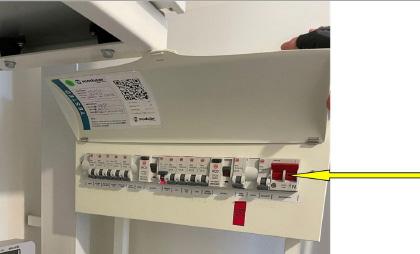
Written below each MCB is a description of the circuit it protects – power, lighting, kitchen etc. If you require the electrical supply to your entire property to be shut off, then fip the main switch to the “OFF” position. If you require the electrical supply to be shut off to specifc area of the property only then fip the relevant MBC on the consumer unit to the “OFF” position. To restore power to the property / circuit fip the switch(s) on the consumer unit back to the “ON” position.

It is recommended that you keep a torch within easy reach of the electrical consumer unit in the event of a power failure.
In the event of a loss of power to the entire property frst check that the main switch on the consumer unit is not in the “OFF” position. If this is the case the fipping, it back to the “ON” position should restore power to the property. If this is not the case, or if the above does not restore power to the property, then please contact the London Borough of Havering. If they are unable to assist, you then contact the electricity service provider Sycous their operating hours are Mon - Fri 08.00 - 20.00, and on Saturday 08.00 - 16.00 on 0333 880 3115 Sycous out of hours (OOH) call service 20.00 - 08.00 on 0333 880 3115 and it will work as a call log – calls will be logged for their customer support team to pick up as priority in the morning.
If there is a loss of power to an individual socket within your property, then:
Disconnect, rather than just switch off, any appliance connected to the circuit on which the fault has occurred. The switch on the affected MCB within the consumer unit will be in the “OFF” position. Switching the MCB to the “ON” position should restore power to the affected circuit. Do not keep switching the MCB on and off if it does not restore power to the circuit or will not stay in the “ON” position.
If the cause of the fault cannot be identifed, or the power to the affected circuit cannot be restored then contact the Building Management Agent or a qualifed electrician, as you may, for example, have a fault within a ftted socket or switch.
The main cold water shut off valve is located Utility Cupboard and can be used to completely shut off the cold-water supply to your entire property by turning the handle 90° so that it no longer points in the same direction as the pipe.
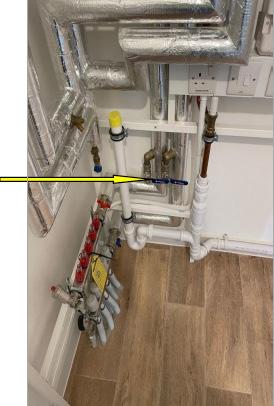

The water supply enters your property via the water meter, located in the communal riser cupboard. Local isolation valves have been installed on the cold-water pipework before it connects to the kitchen sink.
The isolation valves to the bathroom sanitary ware are located in the Utility Cupboard as per fgs. 2 & 3. The water supply to the item can be shut off by turning the handle 90° so that it no longer points in the same direction as the pipe.
In the event of a total loss of cold water to your property frst check that the main isolation valve is in the “OPEN” position, (the handle will be pointing in the same direction as the pipe). If the valve is in the open position and you still have no water, then please contact the Havering Contact Centre. If they are unable to assist, you then contact the water service provider Essex and Suffolk Water on 0345 782 0111
If there is a loss of water to an individual appliance of item of sanitary ware frst check that the local isolation valve is in the “OPEN” position, (the handle will be pointing in the same direction as the pipe). If this does not restore the water supply to the item / appliance, then contact the Building Management Agent or a registered plumber who will be able to further assist you.
In the event of a water leak being discovered in your own property, you should attempt to mitigate the effects of the water ingress and identify the location and cause of the leak to establish the means of isolation of the affected area.
In the event the water leak is coming from an installed appliance such as a washing machine or dishwasher, then the appliance can be isolated via the isolation valves installed on the pipework local to the equipment.
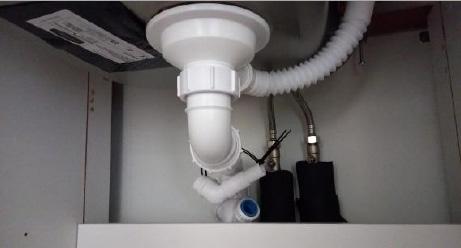
In the event of a large unknown continuing water leak shut off the water supply to your property via the main isolation valve.
When the water leak has been isolated, repairs should be arranged by contacting the Building Management Agent or a registered plumber directly.
In the event a large amount of water has leaked the Building Management Agent must be contacted to prevent spreading to other areas and lower levels.
If water is found to have spread to areas containing electrical wiring a qualifed
electrician should be contacted to carry out a thorough inspection.
Residents are reminded that most insurance companies will expect an attempt to be made to prevent the ingress of water in a food situation. For this purpose, if possible, use towels etc to form a dam around the source of the leak to control the spread of water and limit the damage.
In the event of a water leak being discovered outside your property please inform the London Borough of Havering immediately and tell them of the location and severity so that it can be rectifed.
The apartment is heated with Under Floor heating. This is controlled using the Neostat V2 Touchscreen 7 Day Programmer located in the Lobby/Hallway. There are also dial thermostats for each individual room. For details of the operation of the heating system controls refer to the manufacturer’s literature in the Resident’s Handover Pack and also by clicking the link or scanning the QR code below for video instructions.
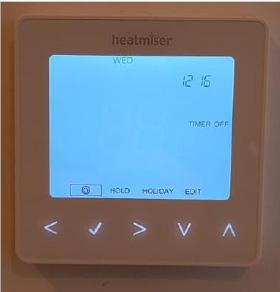
www.shorturl.at/nrL45

A residential integrated reception system has been provided for your property. Services that are available (subscription maybe required) are as follows:
Sky Digital
Sky HD
Sky + Sky Q
Hotbird
Digital Terrestrial TV (Freeview)
FM Radio
DAB Radio
A multi-service outlet plate has been installed in the Living Room and all bedrooms of the apartment.

Access will be required for servicing of your mechanical and electrical equipment within your property
Full instructions can be found in your Residents Handover Pack and also by scanning the QR code or clicking the link below:

www.shorturl.at/nrL45
Access via communal entrances, Key Fob is required to access the buildings, lifts, and apartments. Guests can contact the resident’s intercom handset via the ground foor panel.
Access to the car park areas is restricted and is programmed to individual resident’s access FOB keys. There is a separate FOB system to access the secure car park gates.
Please note there is no parking space available for visitors
Communal Areas are covered by CCTV across the development. The London Borough of Havering is responsible for this system and should be contacted if there is a need to see footage.
Residents will not have direct access to CCTV images. Any requests for footage should be made either through insurance companies for any civil or property claims, or from the Police for any footage relating to (criminal) investigations.
3 No. keys are provided for your entrance door and 3 No. keys for your patio/balcony doors, 2 no. each window type and 2 no. letterbox.
You will also be given 2 No. Fobs for the security doors. The Fobs will operate the following:
• Main Entrance Door
• Lift Door to your Floor Level
• Staircase Entrance to your Floor
• Cycle store (if applicable)
• Bin Stores on the Ground Floor
Please ensure you keep your keys safe and do not lend out to other residents. Please remember that the front door to your fat is NOT locked just by shutting it.
If you lose your Keys/Fobs, please contact London Borough of Havering Housing Contact Centre on 01708 434000.
We have installed a video entry system that allows you to see every visitor before deciding upon granting them access. The Video Entry System is installed to your home via the wall mounted intercom panel which is complete with a built-in video screen to view the caller. Instructions are available in your Residents Pack and also by scanning the QR code or clicking the link below:

www.shorturl.at/nrL45
Your intercom panel connects to the entry panels located outside the main entrance to the building
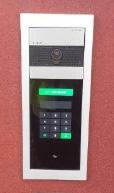
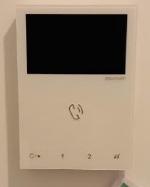
Role Name
Local Authority London Borough of Havering
Contact Details
Town Hall
Main Road, Romford, RM1 3BB
Tel: 01708 434000
Web: www.havering.gov.uk
Tel: 0800 138 2322
Electricity Npower
Monday – Friday 9am – 5pm (excluding Bank Holidays)
Sandon Valley House
Canon Barns Rd, Chelmsford
Water Essex & Suffolk Water
Telephone/ Broadband/ TV BT
Telephone/ Broadband Hyperoptic
Telephone/ Broadband/ TV Sky
Local Police Dagenham Police Station
CM3 8BD
Tel: 0345 782 0999
Web: www.eswater.co.uk
1 Braham St London, E1 8EE
Tel: 0800 800 150
Web: www.bt.com
174 Hammersmith Rd, London, W6 7JP
Tel: 0333 332 1111
Web: www.hyperoptic.com
Grant Way, Isleworth
Middlesex, TW7 5QD
Tel: 0333 759 1018
Web: https://www.sky.com/tv
561 Rainham Rd, S Dagenham RM10 7TU
Tel: 02072301212 Hospital Queen’s Hospital
Rom Valley Way, Romford, RM7 0AG
Tel: 03304004333
www.bhrhospitals.nhs.uk
Suite 410
Transport
Energy Saving Guidance
Energy Saving Trust
1 Northumberland Ave, Westminster London, WC2N 5BW
Tel: 03457 484950
Web: www.nationalrail.co.uk
4th Floor, 14 Pier Walk
London, SE10 0ES
Tel: 08001123456
Web: www.tf.gov.uk
21 Dartmouth Street
London, SW1H 9BP
Tel: 0300 123 1234
Web: www.energysavingtrust.org.uk
2 Cathedral Square, College Green Bristol, BS1 5DD
Tel: 0117 926 8893
Web: www.sustrans.org.uk
Your new home has programmers, controls and systems that you may not have used before and sometimes when these go wrong, they can be re-set or checked by yourself to help resolve issues in the fastest manner.
Programmable
Programmable
fault
Possible Cause Remedy
Shower/Bath not draining Blocked hair trap Clean hair trap
Shower/Bath not leaking Mastic sealant is damaged
Shower Leaking
Water coming through shower screen
Replace Mastic/sealant - Note: Abrasive cleaning products should not be used
Shower screens are not fully sealed units, they are designed to keep water in and are not designed to have water spayed directly at the seals
Condensation occurs natural, especially when property is drying out, and this can cause mould. Try these tips to prevent mould from forming:
• Use the Ventilation System 24/7
• Keep wardrobes a little open and furniture away from walls to ventilate rooms
• Use green cleaning products
• Dry wet areas
• Keep indoor plants
• If drying clothes, do so near a ventilated area
Should you discover mould or mildew which can be identifed by small black dots and patches, this can be removed by the following:
• First, put on a pair of rubber gloves
• Mix a solution of one-part bleach to three-parts warm water
• Using a (preferably) new sponge, gently dab the solution onto the
• affected areas. Take care to ensure your bathroom is well ventilated
• Leave the solution on the mould for a few minutes, then wipe away
• with a cloth or the sponge. If you fnd it’s particularly stubborn, you can
• leave the solution on for longer, or even soak cotton wool in it and place
• the wool on top of the mould for an hour or so.
Tilt and Turn Windows
Tilt and turn windows can be opened fully like a casement window (inwards) or they can be tilted from the bottom so that the top of the window is angled into the room, giving a smaller opening for ventilation. The tilted opening should be used primarily for ventilation, whilst the turn function should be used primarily for cleaning the outside pane of glass.
The tilt function (bottom hung) is activated by turning the handle 90° to a horizontal position, then tilting the sash inward to provide an opening. To activate the window’s turn function (side hung), the key must be turned 45° clockwise at the same time as the handle is turned 180° to its upright position.
When the window is closed, the turn function automatically locks again. The window can be fully locked by turning the key 180° anti-clockwise.
Constant use and stress on the window can create mechanical problems that reduce the ease of use and performance of a window. Ensuring that the mechanics receive an annual lubrication can reduce the likelihood of damages through wear and tear.
Check your power outlets and the fuse, it could be as simple as ficking a switch or changing the fuse. Another thing to do is to give your appliance time to cool down, if you’ve used your appliance a lot in a small space of time it might have over- heated.
Prevention is better
Place mats inside of the front door to trap the dirt. This will stop outside dirt from getting onto your carpet.
Vacuum regularly
To preserve your carpets beauty and appearance for a long time, we recommend that you vacuum the whole carpet area at least twice a week. We recommend a vacuum cleaner with rotating soft brushes (although not advised for high pile shaggy carpet). These vacuum cleaners are a little more expensive, but far more effective. This is the only way of removing deep-down dirt and the carpet pile will recover more quickly. For dense carpets we recommend reducing the suction power of the vacuum cleaner. Some models feature a variable motor speed, while others require the opening of an air gate to reduce the air fow. Slight dirty marks and stains can best be removed with a carpet cleaning product.
Read the instructions for use carefully and always treat stains as quickly as possible.
Clean in-depth
If you have taken care to vacuum your carpet regularly and remove spills, you may not need to clean your carpet for a year or more, even if it is a light colour. However, when the carpet does start to look soiled, you can either have it professionally cleaned or do it yourself. If you decide to clean the carpet yourself, make sure you use a good quality cleaning agent and carefully follow the manufacturer’s instructions
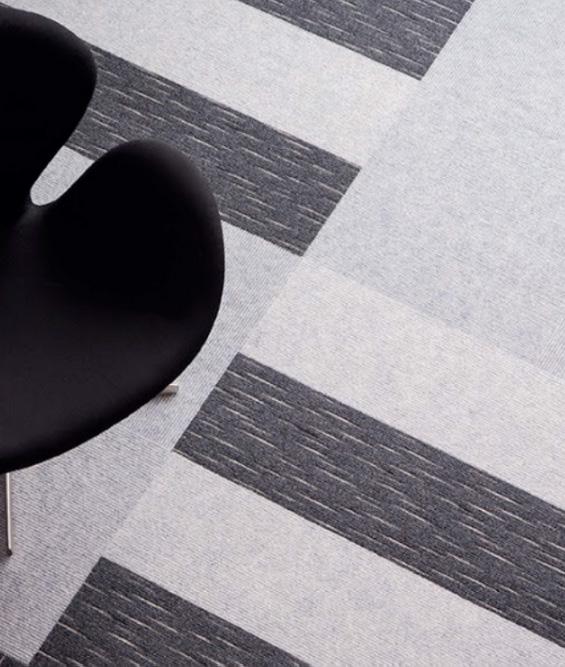

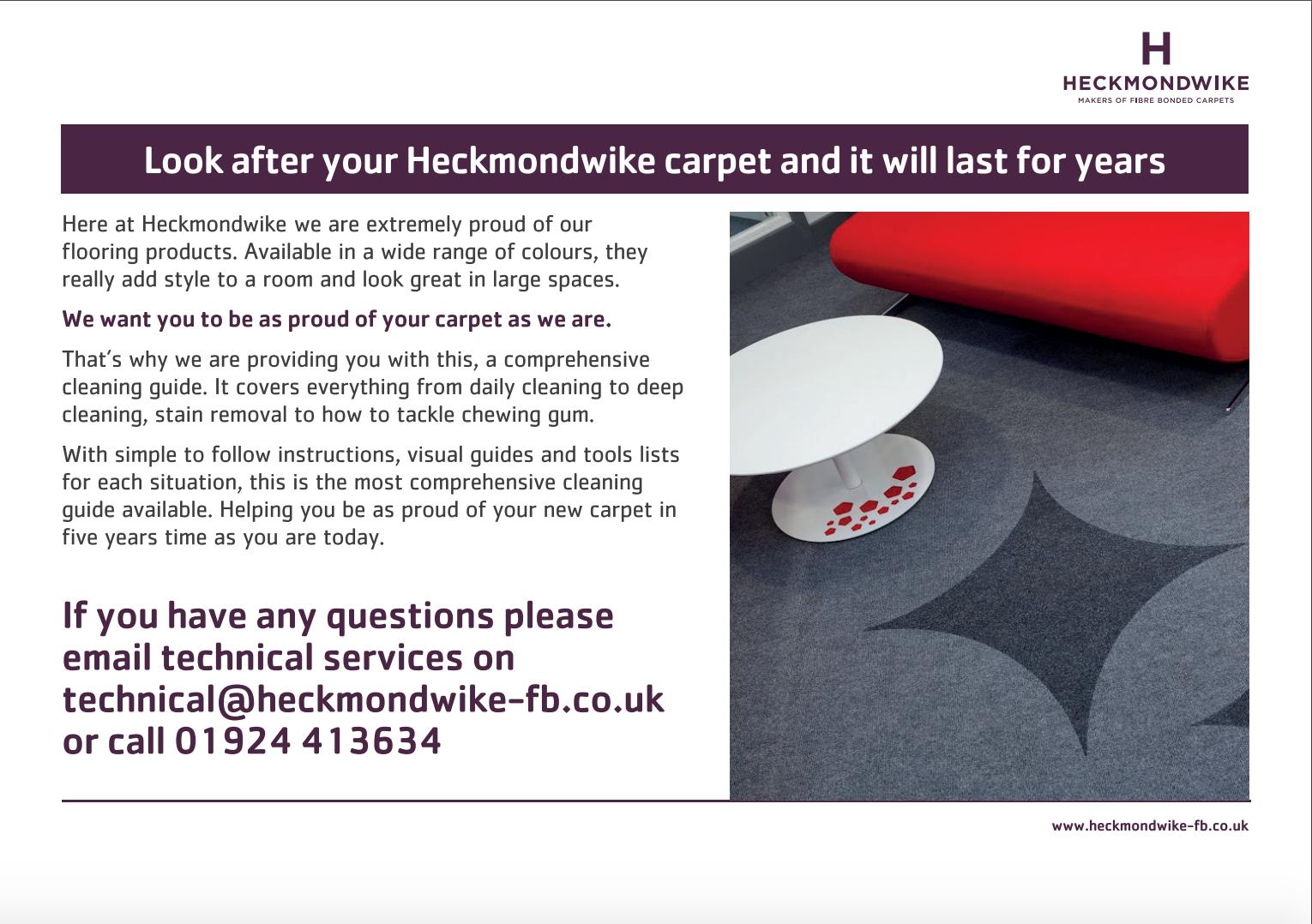
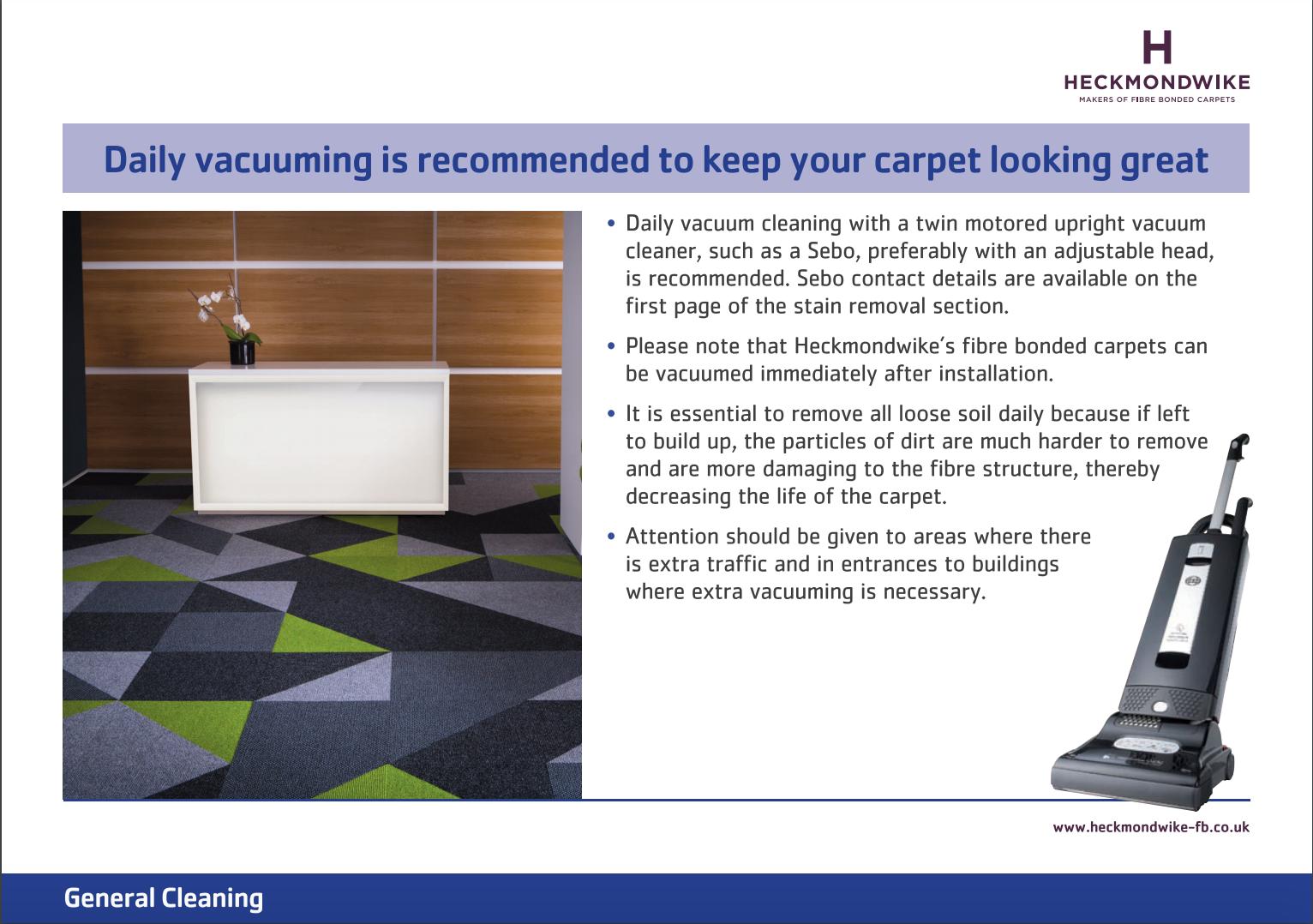
Wherever possible our recommendations should be strictly followed. Immediately blot with a clean absorbent cloth. If any further stain remains or has otherwise been allowed to dry, the method will vary accordingly. If stains are not dealt with immediately, the type of stain may not be able to be identified. Stains left over a period of time become increasingly difficult to remove and may require several treatments. Most stains can be successfully dealt with by the use of either a good quality multi-purpose stain remover, such as Granwax Ezee Spot and Stain Remover or a solvent-based cleaner, such as Prochem Solvall (solvent cleaning of bitumen backed tiles should preferably be avoided, where this is not possible, extra caution should be taken and only very light surface cleaning should take place).

In all cases after stain removal, the carpet should be allowed to dry completed and then cleaned with a twin motored upright vacuum cleaner.

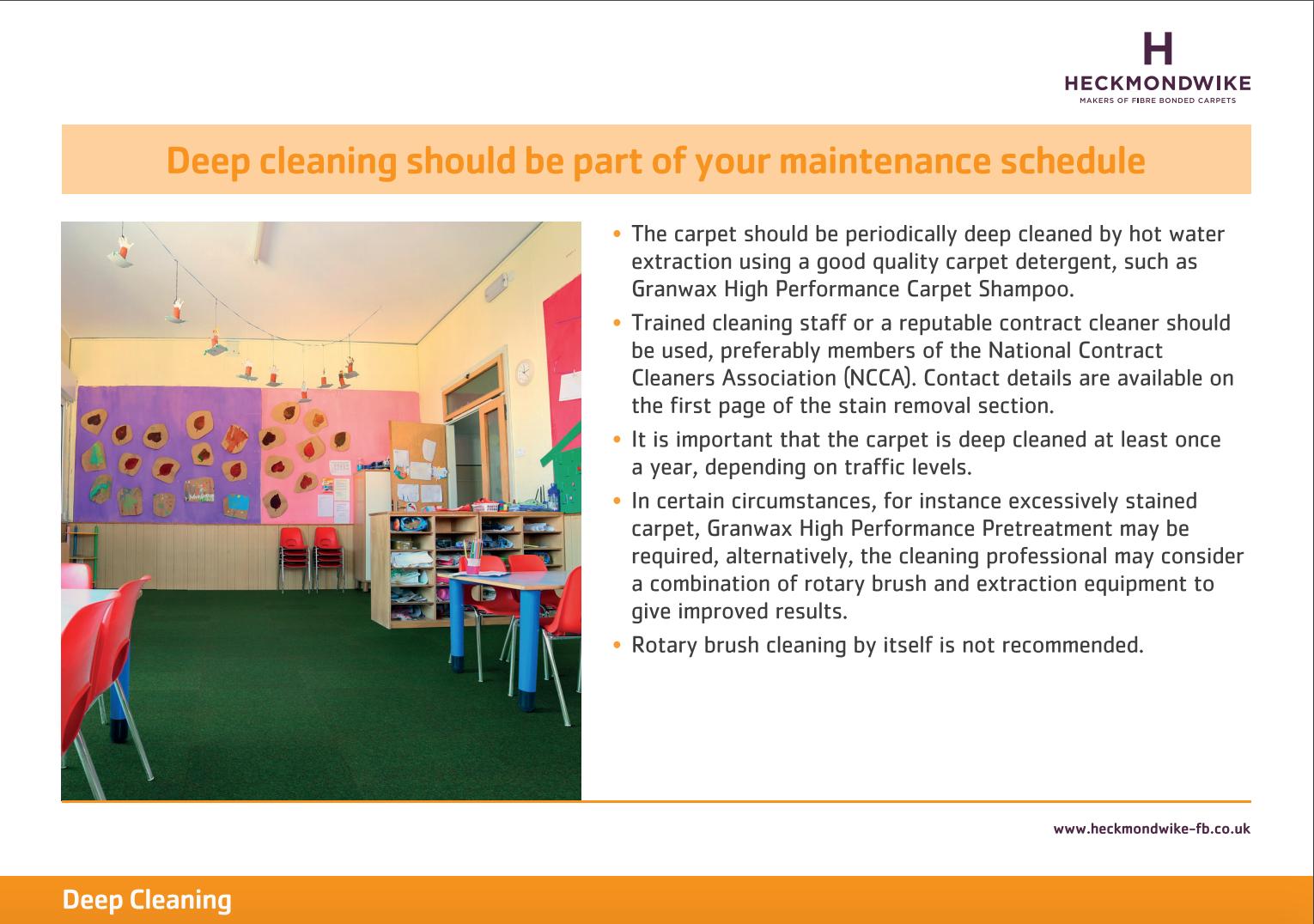
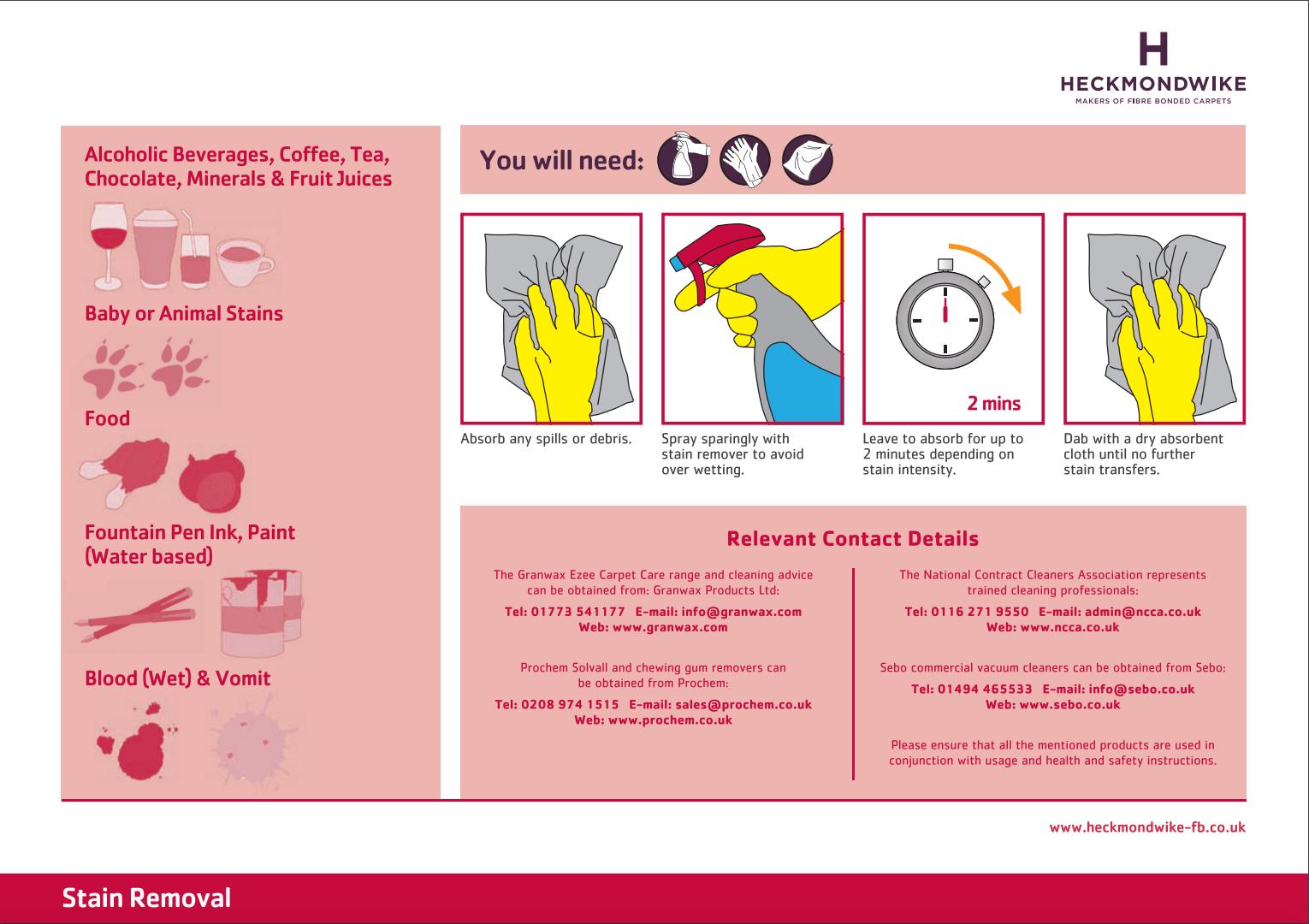
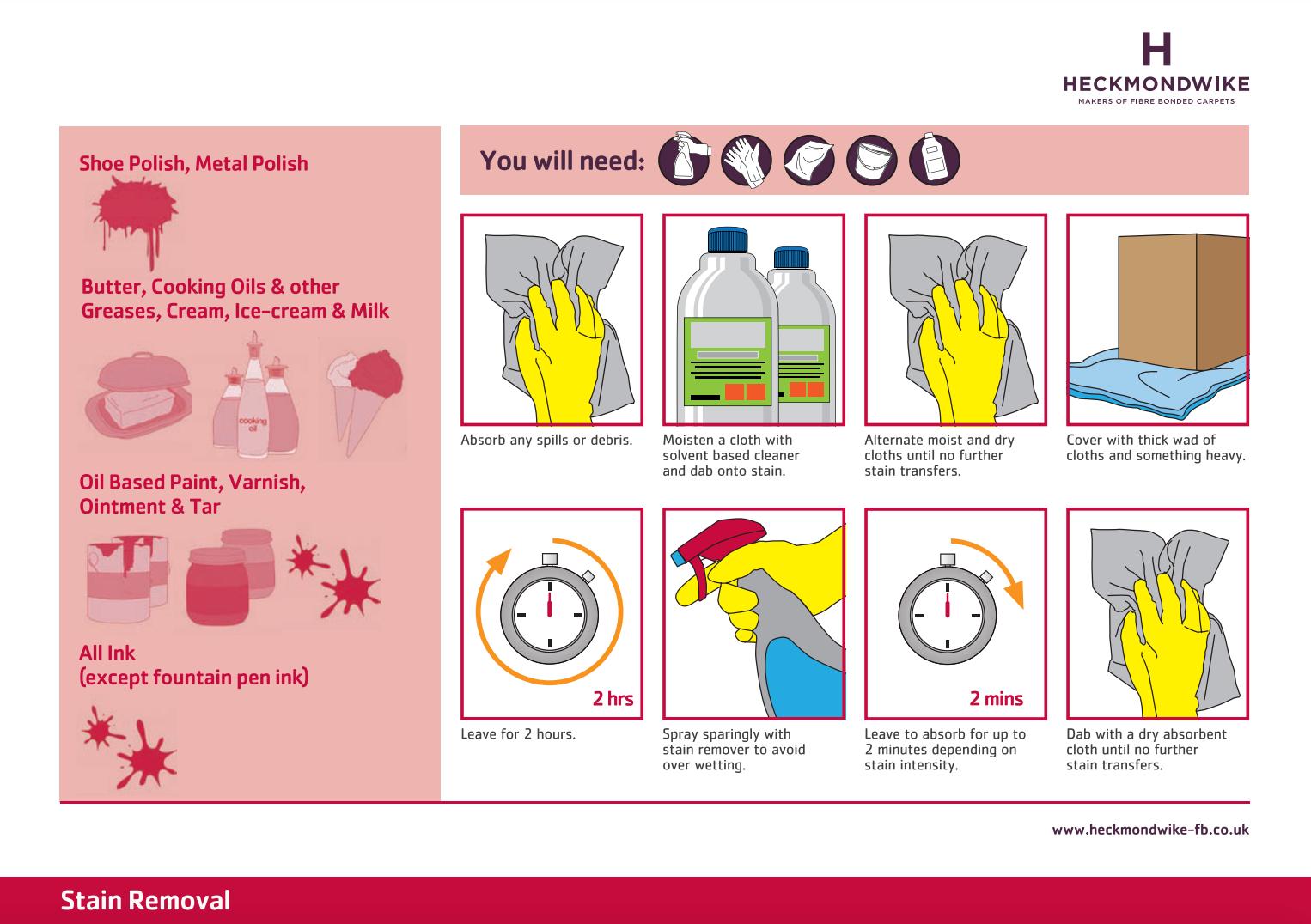

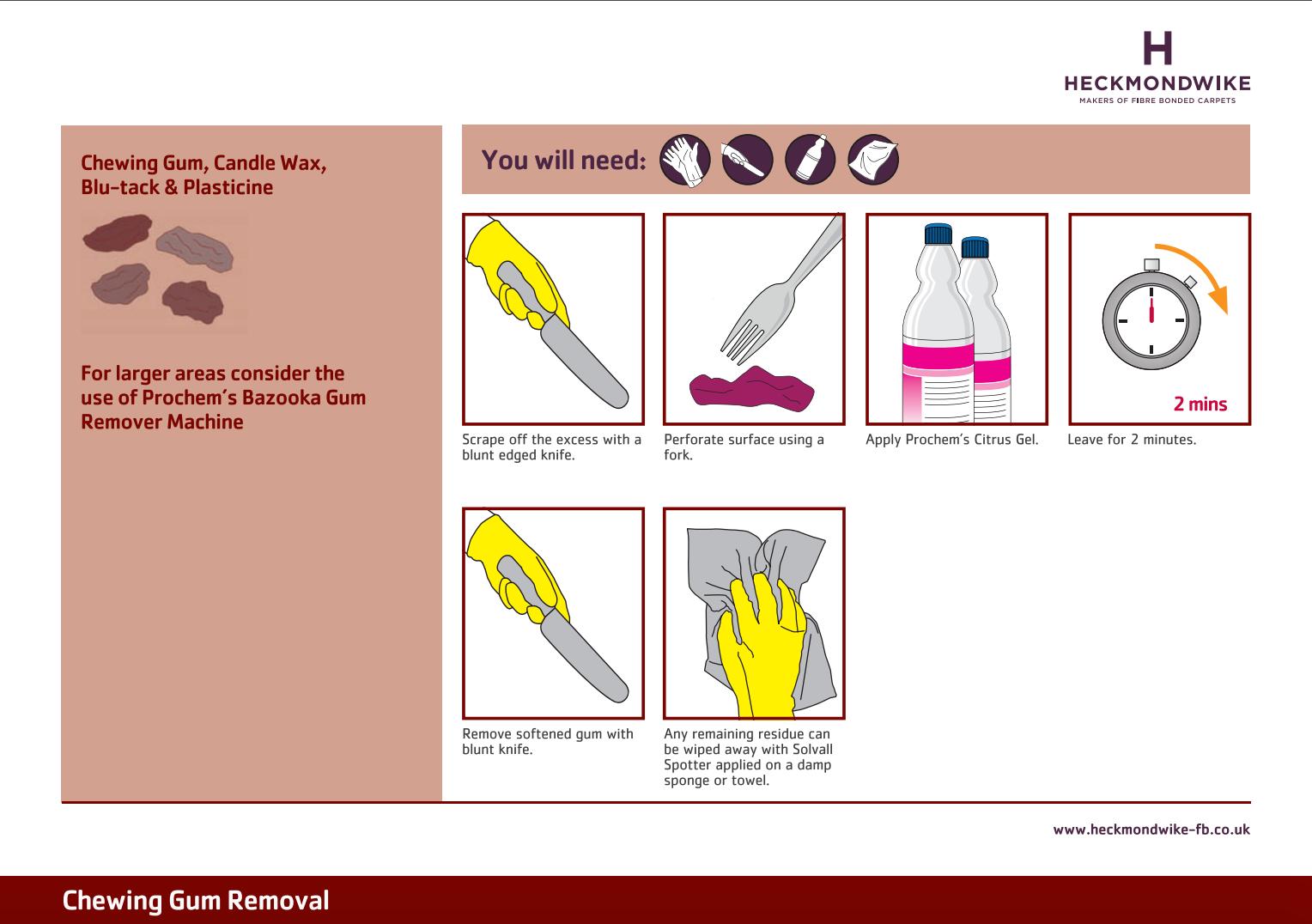
A helpful guide to making the most of your Uniquely Amtico floor

• LVT is a low maintenance product however we would recommend dust mopping or sweeping with a soft brush day-to-day, and damp mopping the floor weekly.
• To damp mop, use Amtico Maintainer (dilute as recommended on the instructions), a traditional string mop and standard wringer bucket.
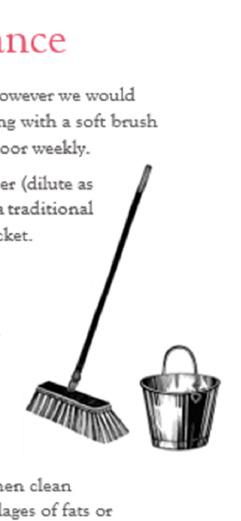
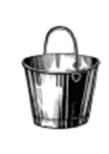
• Work backwards to the door in an ‘S shape’ to mop.
• Rinse and wring the mop frequently.
• Wipe any spillages immediately then clean using Amtico Spillage Remover. Spillages of fats or grease can make the floors slippery.
• Light scuff and abrasion marks can be removed by applying Spillage Remover and gently rubbing with the Amtico cleaning pad or other similar nonabrasive pads.
• Be careful when using furniture or glass polish as an overspray of silicone can make the surface slippery.
• We recommend only using Amtico Maintenance products. Other products may lead to inferior results or leave harmful residues.
• Take care to avoid staining. Blot up accidental spillages as soon as possible with a clean absorbant cloth or paper towel using Amtico Spillage Remover or diluted Maintainer.
• Regularly remove dust and dirt using a dust mop.
• Use an Amtico entrance mat to reduce the chance of dirt, grime and grit being walked onto your floor.
• Remove dry or hardened substances with a blunt scraper or plastic spatula. Do not use steam cleaners.
• If vacuuming, dust mop first and check that nothing sharp is in contact with the floor which could get stuck under the vacuum and cause scratches.
• Use felt pads or furniture glides to protect the floor and add castor cups to spread loads and prevent indentations.
• Avoid contact with rubber e.g., mats or furniture bases.
We would not recommend steam cleaning of our vinyl products for the following reasons:
• Over application of heat and steam may cause delamination of the vinyl product (the layers may separate).
• If the product is fully adhered or perimeter stuck the heat generated from steam cleaning can cause the adhesive to fail.
• The heat over time will soften the surface wear layer of the product causing damage.
• The heat can cause varying issues with the surface layers of the vinyl.
• The heat generated from steam cleaning can cause the vinyl to expand and the product to bubble up from the subfoor.
• The heat and pressure generated by the steam cleaner can cause the edge joints of the material to curl. Unfortunately, there is no conclusive test data available at this time as to the extremes of heat and pressure that most steam cleaning machines will run to and until available, we unfortunately cannot condone their use.
Your new Tarkett Ltd vinyl is tough and long lasting. To help it stay in tiptop condition, here are a few useful hints:
Place large surface plastic castor cups under any armchair legs and heavy furniture and appliances. When moving furniture or heavy appliances which may have sharp feet such as washing machines, freezers, cookers, etc, slide a piece of hardboard or inverted carpet underneath, manoeuvre the appliance onto it, then slide it out onto a second piece of hardboard.
Avoid subjecting the fooring to stiletto heels, sharp knives etc. and hot surfaces such as saucepans. Heavy objects with thin edges can damage the surface of vinyl foorcovering e.g. an iron, heavy tins etc.
Prevent damage to your foorcovering from grit brought in underfoot by having a doormat at entrances from outside. This will save unnecessary cleaning up as well!
Do not use latex/rubber-backed doormats, unless stipulated by their manufacturer that they do not stain vinyl products, as this may discolour your foorcovering.
Mop up spillages on the surface immediately.
Remember, that non safety foorings are slippery when wet.
Sweep up any pieces of grit and dirt.
Regularly damp mop with a suitable micro fbre mopping system and diluted foor cleaner, following the manufacturer’s dilution recommendations.
Thoroughly rinse the foor with clean warm water. Leave this to dry before walking on the foor.
Do not use strong detergents, harsh abrasive powders or wire wool scouring pads, as they will damage the surface of your foorcovering.
Always mop up any spillages immediately.
With certain grades of foorcovering to maintain the ‘as new’ appearance, the foor should be polished initially with
2 coats of a suitable emulsion polish and additional coats for continued maintenance. Our recommended product should be applied in accordance with the manufacturer’s instructions, gradually applying to an area of no more than a 1.5 metres at a time to prevent over application. Polish should not be applied to safety fooring as this will affect the slip resistant properties (advise as to whether polish is required is available on request from Tarkett Ltd Technical Services on Tel: 01622 854 183 or email: uk01.technical@tarkett.com).
Buildup of polish should be removed periodically by stripping the polish and reapplying.
The following can permanently stain your new foorcovering: Shoe polishes, Hair dye, powder paints, wax crayons, some animal excreta, some highly coloured foods
Rubber staining
Some rubbers, which contain certain antioxidants, can permanently stain your foor. Rubber of this type is often used in the manufacture of backings for rugs and mats, protective feet for furniture, wheels for trolleys, rims for assorted objects and equipment, as well as low-cost shoes and slippers (these can all produce a yellow staining on the heavily traffcked areas of your foor).
Recommended cleaning products
Tarkett recommends the use of the following cleaning products: Dettol Complete Clean Multi-Purpose Cleaner, Sainsbury’s Perform All Purpose Cleaner, Tesco All Purpose Cleaner, Strong bleach and pine gel products are not recommended.
Recommended polishing products
Tarkett recommends the use of a suitable vinyl emulsion foor polish or sealer such as Pledge Multi-Surface Wax available via the following stores.
Asda
Morrison
Sainsburys
Waitrose
Wilkinson
NB: Polish should not be applied to safety fooring as this will affect the slip resistant properties.
Use Household ammonia diluted in water – 250ml ammonia to 3 litres of Cold Water, mopping this onto the surface and leaving it to stand for 5 to 10 minutes, (Ammonia can be purchased in local builders merchants). Rinse thoroughly with clean water and allow this to dry before reapplying polish.
Window opening procedures are shown on the Havering video HERE
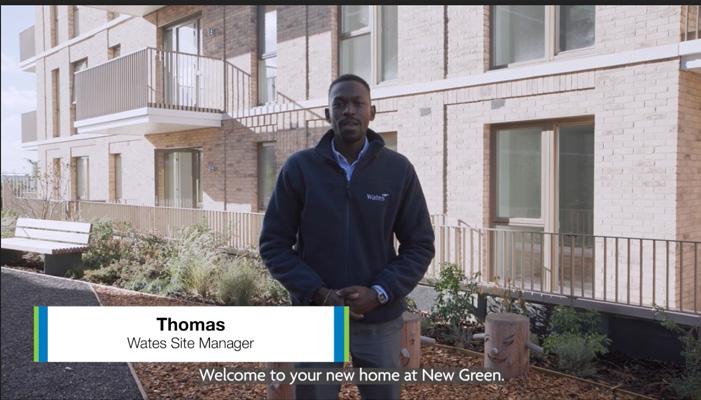
Regardless of what material windows and doors are made from, or how they operate, there are general safety recommendations designed to avoid accidents.

OPEN, CLEAN AND CLOSE - WITHOUT ANY INTERRUPTION!
When preparing to clean a window ensure you can start and fnish without visitors, children, phone calls etc
Always choose a calm and dry day
Never climb on steps or furniture to clean a window
Never lean out of a window or over-reach when stretching up to the op. Use a squeegee on a pole that is as long as needed to do the cleaning safely, with both feet on the foor.
Only use window handle(s)when opening and closing, and always make sure your other hand, and other people’s hands, will not get trapped in any of the sides of the window sash (bottom, sides and top).
Never open outward opening windows on ground foors so much so that there is a risk of passers by colliding into it.
Many types of reversible outward opening window ironmongery include a “scissor” type action.
To avoid the risk of injury never encroach the ironmongery with a fnger or hand!
Never leave a window in a fully open, or a reversed cleaning position- not even for a second! Apart from inviting unwelcome guests, there is also the danger of anything falling out. Always use the recommended ventilation position for day-to- day operation.
Close all windows and doors in strong winds .
NorDan recommend ‘Wurth HHS 5000’ (fully-synthetic creep oil with PTFE) or similar for lubrication of ironmongery. Care should be taken to avoid contact with timber to avoid staining.
Always close a window or door when it is raining to protect its surface and fnish. If not observed, the frame may swell and cause diffculty in closing. This is not only hazardous, but also a common cause of damage to internal fnishings.



